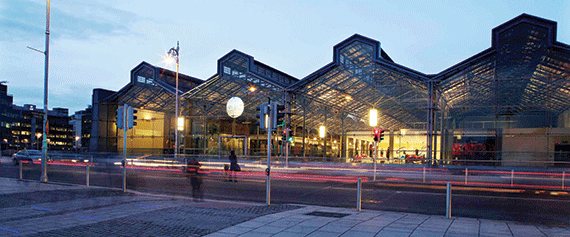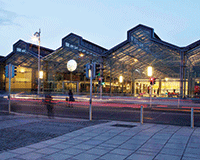
Ireland is facing an office supply problem. Office vacancy in Dublin is at its lowest recorded level, according to JLL. At the same time, take-up was 20% up last year compared with 2013. However, development is not keeping pace with demand, which poses the question – how will the country maintain growth at this crucial point in its recovery?
There is around 1m sq ft of office space under construction and 2.6m sq ft with planning permission in Dublin. This will add 25% to the existing stock, but most of this new space will not be available until 2017 at the earliest.
Development has been held back for a number of reasons. The market crash took a huge number of developers out of the market and banks are cautious about lending money to the ones that remain.
Rents have been rising rapidly – up by 43% in 2014, according to JLL, to €50 (£36) per sq ft – but are still 20% below the last peak in 2006. Crucially, they aren’t quite high enough for most to consider it viable to speculatively build. One or two have pushed the button – the Comer brothers are building a 168,000 sq ft office in Ballsbridge – but this isn’t enough to satisfy demand.
Prelets are one of the few options available to occupiers. James Mulhall from niche agency Murphy Mulhall says: “All space is built to order now and most serious developers aren’t going to come over from the UK to build in a market as small as Dublin.”
He adds: “There was 2.2m sq ft taken up last year and a large portion of this was by new occupiers. We’ll be lucky if we get half that this year as there is simply nowhere for anyone to go.”
Indeed, JLL is predicting take-up for this year of 1.75m sq ft. The firm calculates the vacancy rate in Dublin at 10.2%. This seems high compared with prime London, but a large portion of this stock is obsolete. Refurbishment may save the day. Rents on refurbished stock are rising as a result of demand.
Michael McElligott, managing director of Tetrarch Capital, says: “There is an abject lack of office supply and so more people are moving into refurbished space. Companies like Structure Tone, FKM and Mac Interiors are doing very good business here.”
The former Bank of Ireland headquarters on Lower Baggot Street is being refurbished and extended by Remley and will put 194,000 sq ft of office space into the market by mid-2017.
Twitter, one of Dublin’s major occupiers, is believed to be moving into the 185,000 sq ft former FAS building, which has been renovated by Kennedy Wilson.
An alternative solution to refurbished buildings is for companies to buy sites rather than compete for diminishing existing stock. For example LinkedIn, another major player in Dublin, is investing around £65m in buying and developing a 200,000 sq ft site at Wilton Place because it was unable to find a suitable building already in the market.
But even sites are becoming few and far between, because the National Asset Management Agency is controlling their release. It is understood that the “bad bank” will be stripping sites from its portfolios to auction off for office and residential development. The most recent of these was Project Wave, which will be delivered as a joint venture between Ballymore and Singaporean developers Oxley at North Wall Quay.
North Wall Quay is in the strategic development zone, a scheme set up to encourage controlled development in Dublin. Council planners dealing with this zone have the power to make decisions that cannot be appealed by An Bord Pleanala, Ireland’s planning board, which streamlines the process. While this is a major boost for potential developers, the problem is that these offices will take time to be built.
Despite the problems in Ireland’s market, it still has a lot of advantages. Technology companies are drawn to the country because it has the youngest population in Europe and is the only eurozone country with English as a first language, and this is unlikely to change. Dublin recently came fourth in Savills’ quality of life rankings.
According to JLL, the TMT sector accounted for 39% of take-up last year – a figure that has been rising steadily in the past five years. In 2010 it was just 3% of take-up. Apple’s decision to build a £614.6m data centre in County Galway is evidence of tech sector commitment.
In the short term, companies will find it difficult to find space, meaning take-up figures won’t hit the same heights as last year. However, agents are confident that refurbishments and new flexible working environments will allow continued healthy growth in Dublin.
Ireland’s favourable corporation tax
You can’t discuss the Republic of Ireland without mentioning its favourable tax system. Although there is pressure on the country from Europe, everyone on the ground is confident the 12.5% figure for corporation tax is non-negotiable. The rate has been set since the 1950s and has bipartisan support in the country.
However, the so-called “Double Irish loophole” is being closed in phases. It will mean companies that incorporate in Ireland must be a tax resident there. But it doesn’t seem to have done any major damage to investor confidence.
“The perception of what would happen was worse than the change,” says Colliers International director of business space Paul Finucane.
Keeping the tech guys happy
The fastest-growing companies in Dublin are found in the tech sector, a huge driver of Ireland’s recovery. JLL research shows a massive 39% of demand comes from the sector, but the Irish market is failing to meet its needs.
Tech companies tend to enter the market with a small space and then expand. But this doesn’t suit developers, which are looking for large prelets to anchor developments. To compound the problem, most of the serviced offices in Dublin are now full.
Similarly, flexible leases are attractive to the TMT sector, but landlords are increasingly unwilling to provide them.
Mulhall says: “After things went bad, everyone thought flexible leases would be standard, but longer and more landlord-friendly leases are the norm. It’s the exact opposite of what occupiers need in a recovering economy.”
The final priority for occupiers is a good environment for staff. Many companies looking for space in Dublin have been put off not by high rents but by the type of stock left on the market. Colliers International’s Paul Finucane says: “A lot of companies coming over from San Francisco with 10 employees don’t want grey carpets and suspended ceilings, they want flexible working space and interesting builds.”
Dogpatch Labs is a pioneer of the “pay to play” model that charges companies £288 per desk per month with flexible space and leases. Three Irish start-ups, Intercom, Logentries and Boxever, have used the company’s space and it has expanded into 13,500 sq ft of former retail space at CHQ.
So far, Dogpatch has no competition and can be selective with its customers, but huge demand from the sector means it is only a matter of time before other companies seek to fill this gap.











